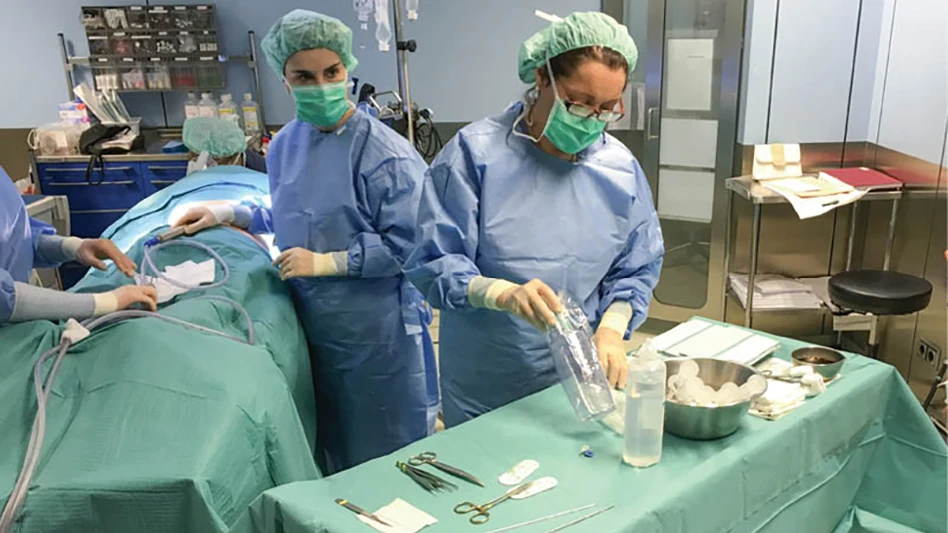
Designing miniature robots to enter the human body and assist with surgical procedures beyond the reach of present technology is on the horizon.
As researchers at the Micro/ Nanophysics Research Laboratory at Australia's Monash University put the final touches to the design of micromotors small enough to be injected into the human bloodstream, they hope to do just this.
A research paper, recently published in the Journal of Micromechanics and Microengineering, detai l s how researchers are harnessing piezoelectricity - the energy force most commonly used to trigger-start a gas stove - to produce microbot motors that are just 250µm wide.
MINIMAL INVASION
Methods of minimally-invasive surgery are preferred by surgeons and patients because of the damage avoided when compared with cut and sew operations. However, serious damage during minimally-invasive surgery is not always avoidable, and surgeons are often limited by, for example, the width of a catheter tube. In serious cases, issues such as width of tubes can fatally puncture narrow arteries.
Soon, remote-controlled miniature robots, small enough to swim up arteries, could save lives by accessing parts of the body - like a strokedamaged cranial artery - that catheters have previously been unable to reach.
With the right sensor equipment attached to the microbot motor, the surgeon's view of a patient's troubled artery can be enhanced. The ability to work remotely also increases the surgeon's dexterity.
"Using conventional technology when you have an injury or a blood clot in the brain, to get to the region, a surgeon will need to push a catheter through the groin to the brain via the carotid artery," Associate Professor James Friend explains. "These catheters have curved tips to allow surgeons to maneuver their way into affected areas. Due to the difficulty reaching certain areas, some 40% of these surgeries fail because as the surgeon uses the catheters, they puncture the artery.
"As you move around the brain the blood vessels get smaller. If there is an injury in smaller arteries you can not get to them using the curved tip because it is too big. But, our robots are the size of two human hairs and can fit into these areas." These micro-robots fit at the tip of a catheter and are connected to a remote control through electric wiring in the catheter. Surgeons find that they can accurately and effectively control the catheter without pushing and pulling, and without a hook.
THE RESEARCH
Friend and his team began their research more than two years ago in the belief that piezoelectricity was the most suitable energy force for micromotors.
The micro-motors can be scaled down, while remaining forceful enough at the sizes necessary to enter the bloodstream, for the motors to swim against the blood's current to difficult-to-reach spots.
Piezoelectricity is based on the ability of some materials to generate electric potential in response to mechanical stress. Friend's miniature robots can swim through the body because he attaches a flagellum to a high-powered rotary micro-motor. These motors spin flagella and can propel the robots through the fluid.
Friend explains, "Opportunities for micro-motors abound in fields as diverse as biomedicine, electronics, aeronautics and the automotive industry. Responses to this need have been just as diverse, with designs developed using electromagnetic, electrostatic, thermal and osmotic driving forces. Piezoelectric designs, however, have favorable scaling characteristics and, in general, are simple designs, which have provided an excellent platform for the development of micro-motors." The team has produced prototypes of the motors and is now working on ways to improve the assembly method and the mechanical device that moves and controls the micro-motors. There are also plans to design prototypes for wireless micro-robots. "These could swim to the injured area and swim out of the body without any catheters involved," Friend concludes.
Monash University
Victoria, Australia
monash.edu.au

Explore the June 2009 Issue
Check out more from this issue and find your next story to read.
Latest from Today's Medical Developments
- Best of 2024: #5 Article – Accelerating medical device development with freeform injection molding
- Best of 2024: #5 News – Complexity, the enduring enemy of medical cybersecurity
- Best of 2024: #6 Article – Closing the global product information gap
- Best of 2024: #6 News – NUBURU enters medical device market with order Blueacre Technology
- Season's greetings
- Best of 2024: #7 Article – Synchronized machining processes for medtech
- Best of 2024: #7 News – 3D printing could revolutionize treatment for cataracts, other eye conditions
- Best of 2024: #8 Article – Perfecting the CMP process for surgical blades





